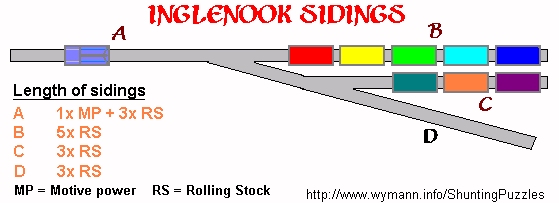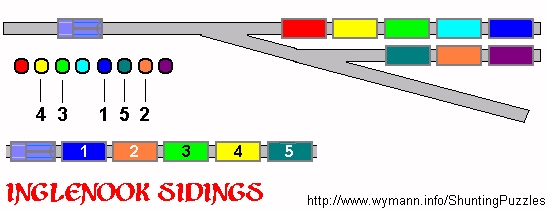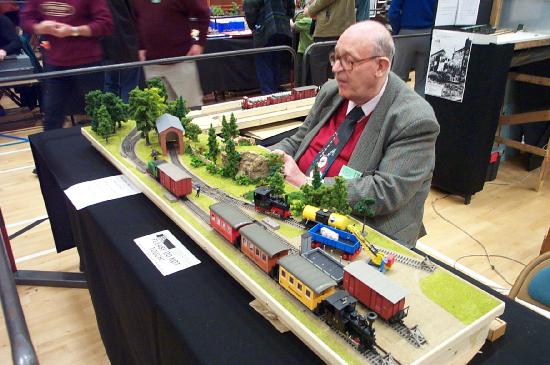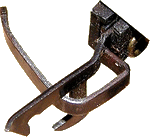|
| |
|
| |
CLASSIC
SHUNTING PUZZLES
INGLENOOK
SIDINGS
|
| |
|
| |
| Possibly the most salient
feature of Inglenook Sidings - the classic
British shunting puzzle par excellence - is its
sheer simplicity in terms of track layout: a single line
of track ending in three stub sidings. |
| |
| There may
in fact be some modellers who never really look
into this shunting puzzle because it may, at
first sight, hardly seem to offer much
operational challenge. But as
is so often the case, first impressions can be
misleading, and it is precisely the simplicity of
the "Inglenook formula" which makes it
work so well and makes operating it so highly
addictive.
|
|
 |
|
| |
| Ultimately,
it is one of those rare examples where a clever and well
balanced combination of a reduced setting and input
actually provides an unexpectedly rich end result, and
Inglenook Sidings is a picture book perfect example of
"reduce to the max". |
| |

|
|
The stroke of
model railway genius embedded in the Inglenook
Sidings formula is not only tied to the track
layout, but most importantly
to the way those sidings are operated.
Only when these two elements are combined is a
shunting layout transformed into an Inglenook
Sidings shunting puzzle. |
|
| |

|
|
First of all, in order for a
shunting layout to be an Inglenook Sidings
puzzle, the length of the three sidings as well
the length of the single track leading up to the
sidings (i.e. the headshunt) need to conform to a
simple set of rules: -
the longest siding holds 5 wagons;
- the two shorter sidings hold 3 wagons each;
- the headshunt allows for the engine plus 3
wagons.
When
operating, a total of 8 wagons plus one engine
will be used.
|
|
| |
| The operational rules of the Inglenook
Sidings stipulate that a departing train needs to be
formed that consists of 5 out of the 8 wagons sitting in
the sidings. |
| |
| The 5
wagons are selected at random, and the train must
be made up of the 5 wagons in the order in which
they are selected. The challenge of
fulfilling this shunting order is linked to the
fact that some advance thinking is required - due
to the fact that there is limited space available
to juggle around the rolling stock, as determined
by the lengths of the individual sidings and the
headshunt.
What
looks like a simple task can thus provoke quite a
bit of headscratching.
|
|
 |
|
| |
| The Inglenook Sidings shunting puzzle is the
brainchild of Alan Wright (1928 -
2005). He built his first small railway, the Wright
Lines, in the early 1950s, and it was on this small
layout (consisiting of a "dented" oval and two
sidings) that he first had the idea of using a five wagon
train on the main line and three wagons in the sidings
(the layout was developed over a couple of
years, was described and illustrated in the Railway
Modeller in 1958, and made a couple of appearances
at exhibitions in the North of England). |
| |
| The way Inglenook Sidings
came into being is quite amusing and took place as
follows: |
| |

Alan
Wright (Chris MacKenzie, Virtual Narrow Gauge
Exhibition, used with kind permission)
|
|
"In
December 1979, with the Manchester show
approaching, my colleagues at work asked what I
would be showing that year and when I said
"nothing" I was taken to task and the
next day one produced a blockboard off cut
4'0" by 1'0" and challenged me to build
a railway on it and show it. Having
some odd pieces of track and a couple of points
Inglenook was born and the 5/3/3 formula was
adopted. It was a roaring success at the show, I
had the small controller on a six feet long lead
and stood among the crowd listening to what they
had to say and then carried out the movements
they wished would happen...
The aura of magic
such operation produced made the crowd wonder if
it was worked by someone watching on television
or was it a computer?" (Alan Wright,
personal communication, 2001)
|
|
| |
| Wright was a railway
man through and through and a locomotive engineer
in his professional life. He had started out as
an apprentice to Hawthorn Leslie on Tyneside in
the mid 1940s and then went on to work for Robert
Stephenson & Co at Darlington before joining
the Vulcan Foundry in Newton-le-Willows in 1964.
There, at his drawing board, he was involved in
the designs of the BR Class 20s, 37s, 40s, 50s
and the mighty Deltics - yet he remained very
proud of the Hawthorn and Stephenson 0-4-0ST and
0-6-0ST steam shunters still at work in and
around the UK at the time which he had helped to
build. Alan
Wright won an award with his shunting puzzle
layout in 1979 and later went on to build several
layout variations on the Inglenook Sidings scheme.
|
|
| |
 |
|
The
inspiration for the basic scheme came
from an actual location, Kilham Sidings,
on the Alnwick-Cornhill branch
(Coldstream branch) of the North Eastern
Railway NER. In its original form, the
5/3/3 formula was therefore worked on the
main line and two sidings (as per the Wright
Lines layout). |
|
|
| |
| On the minimum space Inglenook
Sidings layout this then turned into a stub
line ending in three sidings. An illustrated
article on the second Inglenook Sidings layout
(basically a mirrored trackplan with the
headshunt going off to the right, whereas the
headshunt on the 'original' 1979 layout went off
to the left), authored by Wright himself,
appeared in the December 1992 Railway
Modeller ("Inglenook revisited",
unfortunately out of print). |
|
| |
| In that
article, Wright offered additional insight on his
little shunting puzzle, including the origin of
its name: "The layout of 1979 (...) was
named from the fact that it occupied the space
beside the chimney breast, the inglenook." On
the original Inglenook Sidings, Alan
Wright employed what he called the
"Tiddlywink Computer" for this task,
i.e. distinct tokens for each wagon drawn from a
mug. Incidentally,
the 1992 Inglenook returned to the concept of
having two sidings and a mainline, introducing an
additional operational complication by having one
of the 8 items of rolling stock be a brake van
which "can never be moved off the main
line".
A couple of pictures of
the 1979 layout appeared in C.J. Freezer's Model
Railway Manual (first published in 1994,
several reprints since) and in the December 1984
issue of Scale Model Trains. Alan Wright
also recounted the Inglenook story "so
far" in the May/June 1999 issue (#22) of Model
Trains International.
Alan
Wright's Inglenook Sidings is still considered to
be one possible approach to "perfect railway
modelling", and quite rightly so. In this
ad, a picture from the second version
(left-branching) layout takes center stage.
Apparently,
the 1979 Inglenook Sidings layout still exists
today; when Alan Wright passed away in January
2005 his widow entrusted the original layout to
one of her husband's longtime fellow railway
modellers.
|
|

|
|
| |
| In essence,
the characteristics of this shunting puzzle which make it
so effective are: |
| |
 |
|
- Simple
track layout - it's easy and
quick (and cheap) to build or set up
- Straightforward
rules - they're easy to
understand, memorize, and apply
- Ready to
play in seconds - no extra
equipment needed, any kind of token will
do
- Entertaining
- the puzzle is challenging but never
frustrating
- Non
repetitive - 6,720 different
shunting orders possible
- Small size
- makes an ideal second layout
- Easy to
store - that's where it got its
name from
|
|
| |
|
| |
| There is a certain amount of
befuddlement when it comes to the origins of the Inglenook
Sidings formula - due entirely to looking only at
the track layout consisting of three sidings (which is,
of course, anything but original). Accordingly, even
otherwise reliable sources - such as Cyril J. Freezer in
his Model Railway Manual (first published in
1994, several reprints since) - link Inglenook
Sidings to A.R. Walkley's 1926 "suitcase
layout". Walkley, a member of the Wimbledon Model Railway Club
(the second oldest in Britain), published an
article on his "Railway in a suitcase" in the
June 1926 issue of Model Railway News (reprinted
in Model Trains International #83 in 2009). This freight-only
folding-layout was a trailblazer effort that pioneered HO
scale two-rail operation with locomotives using
permanent magnet motors, allowing them to be reversed
simply by changing the track polarity.
|
| |

|
|
The lasting influence of
Walkley's layout can still be seen on British
outline OO gauge models today:
"The
layout also featured a system of automatic
coupling (really an essential feature for a
shunting layout) which later on was marketed
by Tri-ang, became known as the "tension
lock coupler" and is still used as
standard coupler on many UK ready to run
models today." (Personal
communication, Morgan Lee, longtime librarian
of Wimbledon MRC)
Walkley's
shunting layout was thus a good many things - but
it wasn't the original Inglenook Sidings.
|
|
| |
| Looking at
the 1926 trackplan and photos published in the Model Railway News
it is easy to see where the confusion stems from:
the track configuration on the right hand side of
the layout is the
same as the one used with the Inglenook
Sidings formula. The difference not evident
from the trackplan, however, is that Walkley
didn't operate his layout in Inglenook
Sidings fashion. |
|
 |
|
| |
| The similarity of the track
layouts is all that the "suitcase layout" and Inglenook
Sidings have in common; Alan Wright even pointed out
to me in a personal communication in 2001 that he had
never heard of Walkley or his work when he built the Wright
Lines in the early 1950s. |
| |
|
| |














